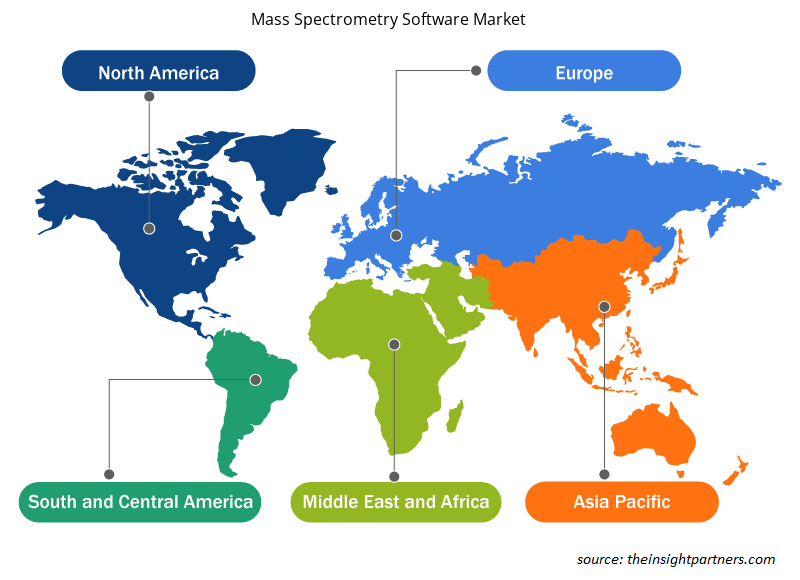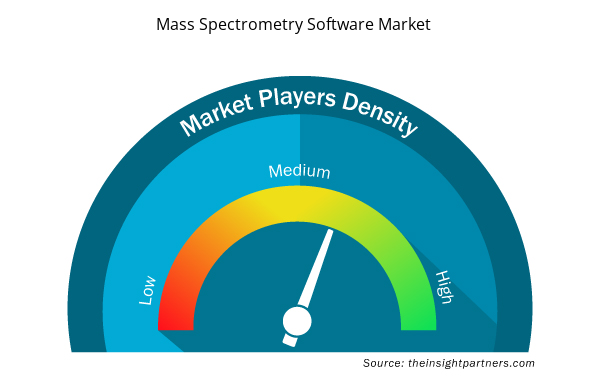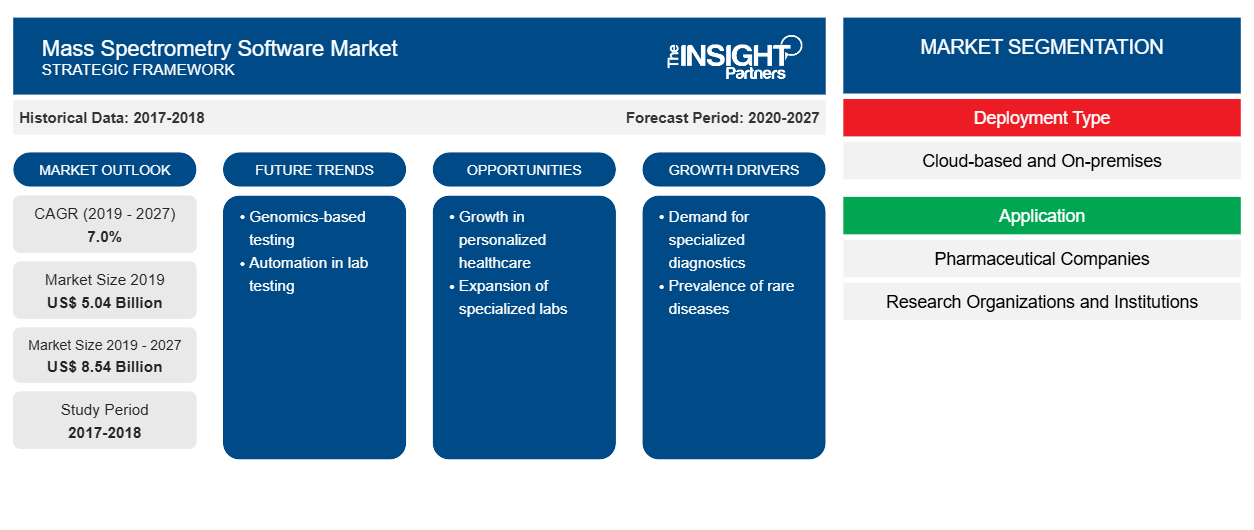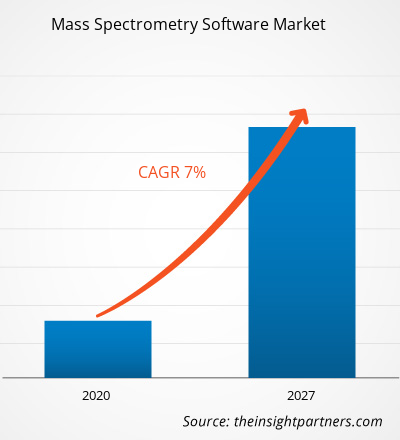Nel 2019, il mercato del software per spettrometria di massa era valutato 5.037,56 milioni di dollari USA e si prevede che raggiungerà gli 8.541,36 milioni di dollari USA entro il 2027; si prevede una crescita a un CAGR del 7,0% dal 2020 al 2027.
Il software di spettrometria di massa aiuta a raccogliere vari strumenti e utensili digitali che forniscono diverse funzionalità e vantaggi per i processi di spettrometria di massa. Il software di spettrometria di massa aiuta nell'analisi dei dati attraverso i suoi strumenti specializzati e aiuta a identificare meglio i biomarcatori proteici e le deviazioni proteiche.
L'ambito del mercato del software di spettrometria di massa include tipo di distribuzione, applicazione e regione. Il mercato del software di spettrometria di massa viene analizzato in base a regioni come Nord America, Europa, Asia Pacifico, Medio Oriente e Africa e Sud e Centro America. Il rapporto offre approfondimenti e analisi approfondite del mercato del software di spettrometria di massa sottolineando vari parametri, come tendenze di mercato, progressi tecnologici, dinamiche di mercato e analisi del panorama competitivo dei principali attori del mercato in tutto il mondo.
Personalizza questo report in base alle tue esigenze
Riceverai la personalizzazione gratuita di qualsiasi report, comprese parti di questo report, o analisi a livello nazionale, pacchetto dati Excel, oltre a usufruire di grandi offerte e sconti per start-up e università
- Scopri le principali tendenze di mercato in questo rapporto.Questo campione GRATUITO includerà analisi di dati che spaziano dalle tendenze di mercato alle stime e alle previsioni.
Approfondimenti di mercato
Crescenti applicazioni della genomica e della proteomica
I crescenti progressi della tecnologia hanno migliorato le applicazioni genomiche e proteomiche nel settore della biotecnologia. Queste applicazioni dipendono principalmente dai risultati di identificazione e quantificazione basati sulla spettrometria di massa. L'integrazione della tecnologia informatica con la biotecnologia ha consentito di ricevere automaticamente database di sequenze genomiche tramite una rapida profilazione proteica. Offre vantaggi come l'analisi in tempo reale di campioni proteici a flusso continuo che possono essere utilizzati per applicazioni mediche.
Le crescenti applicazioni della genomica e della proteomica nel settore medico per la diagnosi e il trattamento delle malattie croniche hanno aumentato l'utilizzo della spettroscopia di massa. La spettrometria di massa ha consentito l'invenzione di tecniche terapeutiche per progettare trattamenti personalizzati per malattie come cancro, diabete e disturbi genetici. Varie innovazioni hanno ricevuto il supporto di organizzazioni governative in tutto il mondo per migliorare la ricerca e lo sviluppo nel settore della biotecnologia. Ad esempio, nel 2006, il National Cancer Institute e il National Human Genome Research Institute hanno collaborato per guidare iniziative significative, come Cancer Genome Atlas, per lo sviluppo di medicinali personalizzati per l'oncologia. Nell'ambito del programma, circa 47 farmaci sono stati approvati dalla Food and Drug Administration nel 2018 e quasi 20 entro la metà del 2019.
Allo stesso modo, nel 2016 è stato lanciato l'International Cancer Proteogenome Consortium (ICPC) per fornire una piattaforma ai principali centri di ricerca mondiali sul cancro e sulla proteogenomica per migliorare la loro ricerca sulla medicina di precisione e le sue sfide per il cancro. L'ICPC è presente in 13 paesi e comprende 33 istituti e 11 membri del Clinical Proteomic Tumor Analysis Consortium. L'aumento della ricerca o dell'applicazione del proteogenoma nel settore medico porta a una crescente domanda di spettroscopia di massa automatizzata. Inoltre, la domanda di software di spettrometria di massa è aumentata da vari istituti accademici e da aziende farmaceutiche e biofarmaceutiche per migliorare le loro attività di ricerca e sviluppo di farmaci. Pertanto, si prevede che l'aumento delle applicazioni di genomica e proteomica guiderà il mercato durante il periodo di previsione.
Informazioni basate sul tipo di distribuzione
In base al tipo di distribuzione, il mercato del software di spettrometria di massa è segmentato in cloud-based e on-premise. Il segmento basato su cloud ha detenuto la quota maggiore del mercato nel 2019. Inoltre, si stima che il segmento registrerà il CAGR più elevato del mercato durante il periodo di previsione grazie alla facile accessibilità ai dati da qualsiasi luogo e in qualsiasi momento. Inoltre, fornisce elevati livelli di sicurezza, scalabilità, accessibilità, convenienza, costi energetici inferiori e distribuzione rapida. Si prevede che ciò accelererà la crescita del mercato.
Approfondimenti basati sulle applicazioni
In base all'applicazione, il mercato del software di spettrometria di massa è segmentato in aziende farmaceutiche, organizzazioni e istituzioni di ricerca e altri. Il segmento delle aziende farmaceutiche ha detenuto la quota maggiore del mercato nel 2019. Si stima che lo stesso segmento registrerà il CAGR più elevato nel mercato durante il periodo di previsione.
Le strategie inorganiche, come partnership, fusioni e acquisizioni, sono comunemente adottate dalle aziende per soddisfare la domanda mutevole dei clienti in tutto il mondo, il che consente anche ai player di mantenere il loro marchio a livello globale. I player di mercato che operano nel mercato del software di spettrometria di massa hanno anche adottato strategie organiche, come il lancio e l'espansione del prodotto, per estendere la loro impronta e il portafoglio di prodotti in tutto il mondo e per soddisfare la domanda crescente.
Approfondimenti regionali sul mercato del software per spettrometria di massa
Le tendenze regionali e i fattori che influenzano il mercato del software per spettrometria di massa durante il periodo di previsione sono stati ampiamente spiegati dagli analisti di Insight Partners. Questa sezione discute anche i segmenti e la geografia del mercato del software per spettrometria di massa in Nord America, Europa, Asia Pacifico, Medio Oriente e Africa e America meridionale e centrale.

- Ottieni i dati specifici regionali per il mercato del software di spettrometria di massa
Ambito del rapporto di mercato del software di spettrometria di massa
| Attributo del report | Dettagli |
|---|---|
| Dimensioni del mercato nel 2019 | 5,04 miliardi di dollari USA |
| Dimensioni del mercato entro il 2027 | 8,54 miliardi di dollari USA |
| CAGR globale (2019 - 2027) | 7,0% |
| Dati storici | 2017-2018 |
| Periodo di previsione | 2020-2027 |
| Segmenti coperti | Per tipo di distribuzione
|
| Regioni e Paesi coperti | America del Nord
|
| Leader di mercato e profili aziendali chiave |
|
Mercato dei software di spettrometria di massa Densità: comprendere il suo impatto sulle dinamiche aziendali
Il mercato del software per spettrometria di massa sta crescendo rapidamente, spinto dalla crescente domanda degli utenti finali dovuta a fattori quali l'evoluzione delle preferenze dei consumatori, i progressi tecnologici e una maggiore consapevolezza dei vantaggi del prodotto. Con l'aumento della domanda, le aziende stanno ampliando le loro offerte, innovando per soddisfare le esigenze dei consumatori e capitalizzando sulle tendenze emergenti, il che alimenta ulteriormente la crescita del mercato.
La densità degli operatori di mercato si riferisce alla distribuzione di aziende o società che operano in un particolare mercato o settore. Indica quanti concorrenti (operatori di mercato) sono presenti in un dato spazio di mercato in relazione alle sue dimensioni o al valore di mercato totale.
Le principali aziende che operano nel mercato del software per spettrometria di massa sono:
- Acque. Società
- Thermo Fisher Scientific Inc.
- Agilent Technologies, Inc.
- Sciex (Società Danaher)
- Sviluppo della chimica avanzata
Disclaimer : le aziende elencate sopra non sono classificate secondo un ordine particolare.

- Ottieni la panoramica dei principali attori del mercato dei software per spettrometria di massa
Per tipo di distribuzione
- Basato su cloud
- In sede
Per applicazione
- Aziende farmaceutiche
- Organizzazioni e istituzioni di ricerca
- Altri
Di
Geografia
America del Nord
- NOI
- Canada
- Messico
Europa
- Francia
- Germania
- Italia
- Regno Unito
- Russia
- Resto d'Europa
Asia Pacifico (APAC)
- Cina
- India
- Corea del Sud
- Giappone
- Australia
- Resto dell'APAC
Medio Oriente e Africa (MEA)
- Sudafrica
- Arabia Saudita
- Emirati Arabi Uniti
- Resto del MEA
America del Sud e Centro (SCAM)
- Brasile
- Argentina
- Resto della TRUFFA
Profili aziendali
- Società di acque
- Thermo Fisher Scientific Inc.
- Agilent Technologies, Inc.
- Sciex (Società Danaher)
- Sviluppo della chimica avanzata
- Bruciatore
- Soluzioni Adaptas
- Società anonima
- Strumenti scientifici Shimadzu
- PerkinElmer, Inc.
- Analisi storica (2 anni), anno base, previsione (7 anni) con CAGR
- Analisi PEST e SWOT
- Valore/volume delle dimensioni del mercato - Globale, regionale, nazionale
- Industria e panorama competitivo
- Set di dati Excel


- Molecular Diagnostics Market
- Foot Orthotic Insoles Market
- Aerospace Forging Market
- Mobile Phone Insurance Market
- Occupational Health Market
- Vertical Farming Crops Market
- USB Device Market
- Arterial Blood Gas Kits Market
- Environmental Consulting Service Market
- Medical and Research Grade Collagen Market

Report Coverage
Revenue forecast, Company Analysis, Industry landscape, Growth factors, and Trends

Segment Covered
This text is related
to segments covered.

Regional Scope
North America, Europe, Asia Pacific, Middle East & Africa, South & Central America

Country Scope
This text is related
to country scope.
Trends and growth analysis reports related to Technology, Media and Telecommunications : READ MORE..
The List of Companies - Mass Spectrometry Software Market
- Waters. Corporation
- Thermo Fisher Scientific Inc.
- Agilent Technologies, Inc.
- Sciex (Danaher Corporation)
- Advanced Chemistry Development
- Bruker
- Adaptas Solutions
- SpectralWorks Ltd.
- Shimadzu Scientific Instruments
- PerkinElmer, Inc.
The Insight Partners performs research in 4 major stages: Data Collection & Secondary Research, Primary Research, Data Analysis and Data Triangulation & Final Review.
- Data Collection and Secondary Research:
As a market research and consulting firm operating from a decade, we have published and advised several client across the globe. First step for any study will start with an assessment of currently available data and insights from existing reports. Further, historical and current market information is collected from Investor Presentations, Annual Reports, SEC Filings, etc., and other information related to company’s performance and market positioning are gathered from Paid Databases (Factiva, Hoovers, and Reuters) and various other publications available in public domain.
Several associations trade associates, technical forums, institutes, societies and organization are accessed to gain technical as well as market related insights through their publications such as research papers, blogs and press releases related to the studies are referred to get cues about the market. Further, white papers, journals, magazines, and other news articles published in last 3 years are scrutinized and analyzed to understand the current market trends.
- Primary Research:
The primarily interview analysis comprise of data obtained from industry participants interview and answers to survey questions gathered by in-house primary team.
For primary research, interviews are conducted with industry experts/CEOs/Marketing Managers/VPs/Subject Matter Experts from both demand and supply side to get a 360-degree view of the market. The primary team conducts several interviews based on the complexity of the markets to understand the various market trends and dynamics which makes research more credible and precise.
A typical research interview fulfils the following functions:
- Provides first-hand information on the market size, market trends, growth trends, competitive landscape, and outlook
- Validates and strengthens in-house secondary research findings
- Develops the analysis team’s expertise and market understanding
Primary research involves email interactions and telephone interviews for each market, category, segment, and sub-segment across geographies. The participants who typically take part in such a process include, but are not limited to:
- Industry participants: VPs, business development managers, market intelligence managers and national sales managers
- Outside experts: Valuation experts, research analysts and key opinion leaders specializing in the electronics and semiconductor industry.
Below is the breakup of our primary respondents by company, designation, and region:

Once we receive the confirmation from primary research sources or primary respondents, we finalize the base year market estimation and forecast the data as per the macroeconomic and microeconomic factors assessed during data collection.
- Data Analysis:
Once data is validated through both secondary as well as primary respondents, we finalize the market estimations by hypothesis formulation and factor analysis at regional and country level.
- Macro-Economic Factor Analysis:
We analyse macroeconomic indicators such the gross domestic product (GDP), increase in the demand for goods and services across industries, technological advancement, regional economic growth, governmental policies, the influence of COVID-19, PEST analysis, and other aspects. This analysis aids in setting benchmarks for various nations/regions and approximating market splits. Additionally, the general trend of the aforementioned components aid in determining the market's development possibilities.
- Country Level Data:
Various factors that are especially aligned to the country are taken into account to determine the market size for a certain area and country, including the presence of vendors, such as headquarters and offices, the country's GDP, demand patterns, and industry growth. To comprehend the market dynamics for the nation, a number of growth variables, inhibitors, application areas, and current market trends are researched. The aforementioned elements aid in determining the country's overall market's growth potential.
- Company Profile:
The “Table of Contents” is formulated by listing and analyzing more than 25 - 30 companies operating in the market ecosystem across geographies. However, we profile only 10 companies as a standard practice in our syndicate reports. These 10 companies comprise leading, emerging, and regional players. Nonetheless, our analysis is not restricted to the 10 listed companies, we also analyze other companies present in the market to develop a holistic view and understand the prevailing trends. The “Company Profiles” section in the report covers key facts, business description, products & services, financial information, SWOT analysis, and key developments. The financial information presented is extracted from the annual reports and official documents of the publicly listed companies. Upon collecting the information for the sections of respective companies, we verify them via various primary sources and then compile the data in respective company profiles. The company level information helps us in deriving the base number as well as in forecasting the market size.
- Developing Base Number:
Aggregation of sales statistics (2020-2022) and macro-economic factor, and other secondary and primary research insights are utilized to arrive at base number and related market shares for 2022. The data gaps are identified in this step and relevant market data is analyzed, collected from paid primary interviews or databases. On finalizing the base year market size, forecasts are developed on the basis of macro-economic, industry and market growth factors and company level analysis.
- Data Triangulation and Final Review:
The market findings and base year market size calculations are validated from supply as well as demand side. Demand side validations are based on macro-economic factor analysis and benchmarks for respective regions and countries. In case of supply side validations, revenues of major companies are estimated (in case not available) based on industry benchmark, approximate number of employees, product portfolio, and primary interviews revenues are gathered. Further revenue from target product/service segment is assessed to avoid overshooting of market statistics. In case of heavy deviations between supply and demand side values, all thes steps are repeated to achieve synchronization.
We follow an iterative model, wherein we share our research findings with Subject Matter Experts (SME’s) and Key Opinion Leaders (KOLs) until consensus view of the market is not formulated – this model negates any drastic deviation in the opinions of experts. Only validated and universally acceptable research findings are quoted in our reports.
We have important check points that we use to validate our research findings – which we call – data triangulation, where we validate the information, we generate from secondary sources with primary interviews and then we re-validate with our internal data bases and Subject matter experts. This comprehensive model enables us to deliver high quality, reliable data in shortest possible time.


 Ottieni un campione gratuito per questo repot
Ottieni un campione gratuito per questo repot